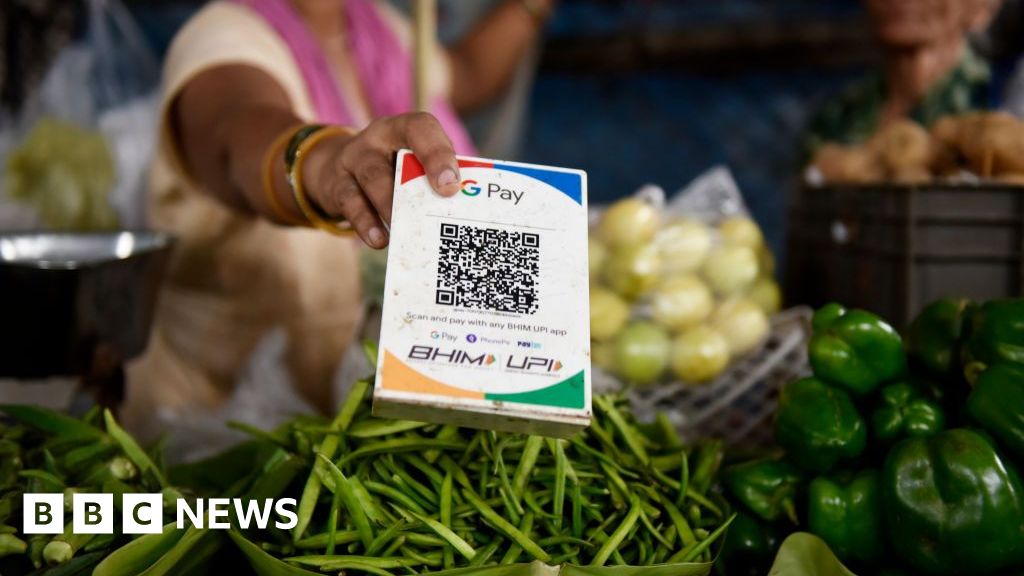- author, Priti Gupta
- role, Technology Reporter
- Reported by Mumbai
Arun Kumar has been running a fruit stall on a busy street in Mumbai every day for the past seven years.
It’s not an easy way to make a living.
“Being a street vendor is difficult. I risk being robbed and because I’m not a licensed vendor, local authorities can come and demolish my shop at any time,” he said.
But over the past four years, at least one aspect of his job has gotten easier.
“Pre-COVID, it was all cash. But now everyone pays with UPI. You scan the code and the payment is made within seconds.”
“I no longer have any problems handling cash or giving change to customers. It has made life and business smoother,” he said.
UPI, or its official name is Unified Payments Interface, was launched in 2016 by India’s central bank in collaboration with the country’s banking industry.
It’s an app-based instant payments system that allows users to send and receive money, pay bills and authorise payments in a single step, without having to enter bank details or other personal information – and perhaps most importantly, it’s free.
UPI recorded 14 billion transactions in May, up from 9 billion a year ago.
Image source, Getty Images
But its popularity and ease of use make it perfect prey for scammers.
“Digital payments are convenient but they also come with vulnerabilities,” said Shashank Shekhar, founder of the Delhi-based Future Crime Research Foundation.
Shekhar said fraudsters are tricking people in various ways, including convincing them to give up their UPI PIN numbers, which are needed to authorise payments.
Some fraudsters create fake UPI apps that are clones of genuine banking apps and steal login details and other valuable information.
“Given the speed at which digital transformation has happened in the country, it is unfortunate that digital literacy and safe internet practices have not kept pace,” Shekhar said.
He said that almost half of the financial fraud cases that occurred between January 2020 and June 2023 involved the use of the UPI system.
According to government statistics, there were more than 95,000 fraud cases involving UPI in the financial year ending April 2023, up from 77,000 the previous year.
Shivkari is one such victim: she had always wanted to own a scooter but lacked the budget.
But earlier this year, the 22-year-old man from India’s northeastern state of Bihar came across what he thought was a good deal when he saw a car for sale on Facebook.
“I took the opportunity without a second thought,” she says.
After a few clicks, she spoke with the owner, who said he would send her the vehicle paperwork for $23.
That went smoothly, so Shivkari kept sending money to the owner through Instant Money Transfer until she finally paid $200, but the scooter (also called a scooty in India) was never delivered.
Shivkari realised that he had been duped.
“I have a certain level of education and I know what’s going on in the world, so I didn’t think I would be fooled. But scammers are smart – they have the art of persuasive speech,” she said.
The government and central bank are considering ways to protect UPI users from fraudsters.
But for now, victims must contact their banks if they want compensation.
“This problem runs deep,” says financial crime expert Dr Durgesh Pandey.
“Most of the blame lies with the banks and telecommunications companies. They fail to check identities, which is why they can’t track down the fraudsters.”
“But what is particularly challenging for banks is the balance they have to strike between inclusivity, ease of doing business and enforcing identity checks. If banks are too strict, vulnerable sections of society will remain without access to banking services.”
But Dr Pandey argues that in most fraud cases, banks are not fully liable.
“This is a complex issue. The problem lies with the banks, but in most cases it’s the victims who provide the identification. I think both the victims and the banks should bear the losses.”
Image source, Poonam Untwal
Despite these challenges, UPI is being promoted in rural areas where access to banking services is difficult.
Poonam Untwal from Rajasthan runs a coaching centre helping people use the internet and digital banking.
“Most of us are not that educated and don’t know how to use smartphones properly. I teach my children that mobile phones are no longer just a device for talking to people, but also a device that gives you banking at your fingertips,” she says.
She believes UPI will help boost the local economy.
“Many women like me run small businesses from home. Now, we can send and receive money through UPI. Even those who don’t have smartphones come to my centre to complete their transactions,” she says.
UPI is not only expanding into local areas, but also internationally.
Retailers in Bhutan, Mauritius, Nepal, Singapore, Sri Lanka and the UAE accept UPI payments.
And this year, France became the first European country to introduce UPI payments, starting with Eiffel Tower admission tickets.
Now back in Mumbai, Kumar is happy he no longer needs to use cash, but remains wary.
Without a good internet connection, customers may accidentally or intentionally run away without paying.
“For a small business like me, [UPI] It has become so easy to receive money now. But I am scared of getting scammed. I often hear in the news that UPI scams are on the rise. I hope they invent a mechanism to ensure that small merchants like me do not incur losses.”


